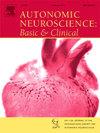剖析心力衰竭的运动加压反射:多步骤失败。
IF 3.3
4区 医学
Q2 NEUROSCIENCES
引用次数: 0
摘要
源自肢体肌肉运动的神经反馈对心血管运动反应的贡献在近100年前首次被认识到。今天,已经确定这种影响是由末端位于收缩骨骼肌内的III和IV组感觉神经元的激活引起的。在运动过程中,这些感觉神经元将与肌内机械和代谢扰动相关的反馈投射到延髓神经回路,从而反射性地引起副交感神经系统活动的减少和交感神经系统活动的增加,以优化中枢和外周血流动力学。来自动物和人体研究的大量证据表明,这种被称为运动加压反射(EPR)的调节控制系统的功能在心力衰竭中是异常的,它会夸大交感神经兴奋,从而损害对运动的血液动力学反应,并导致这些患者的功能限制。本文简要介绍了健康中EPR控制的关键决定因素,并涵盖了心力衰竭对其每个组成部分的完整性和整体功能的影响。这些包括III/IV组肌肉传入神经的敏感性,脊髓传入信号的传递,以及脑干内感觉反馈的中枢整合和处理。重要的是,尽管与本综述相关的大多数数据来自HFrEF研究,但有限的hfpef特异性见解也包括在内。虽然可以说不是EPR的一部分,但我们也讨论了心力衰竭对运动诱导的III/IV组肌肉传入刺激增加和终末器官对交感/神经化学刺激的反应的影响。本文章由计算机程序翻译,如有差异,请以英文原文为准。
Dissecting the exercise pressor reflex in heart failure: A multi-step failure
The contribution of neural feedback originating from exercising limb muscles to the cardiovascular response to exercise was first recognized nearly 100 years ago. Today, it is well established that this influence is initiated by the activation of group III and IV sensory neurons with terminal endings located within contracting skeletal muscle. During exercise, these sensory neurons project feedback related to intramuscular mechanical and metabolic perturbations to medullary neural circuits which reflexively evoke decreases in parasympathetic and increases in sympathetic nervous system activity with the purpose of optimizing central and peripheral hemodynamics. Considerable evidence from animal and human studies suggests that the function of this regulatory control system, known as the exercise pressor reflex (EPR), is abnormal in heart failure and exaggerates sympatho-excitation which impairs the hemodynamic response to exercise and contributes to the functional limitations characterizing these patients. This review briefly introduces the key determinants of EPR control in health and covers the impact of heart failure on the integrity of each of its components and overall function. These include the sensitivity of group III/IV muscle afferents, afferent signal transmission in the spinal cord, and the central integration and processing of sensory feedback within the brainstem. Importantly, although most data relevant for this review come from studies in HFrEF, the limited HFpEF-specific insights are included when available. While arguably not part of the EPR, we also discuss the impact of heart failure on the exercise-induced increase of intramuscular stimuli of group III/IV muscle afferents and end-organ responsiveness to sympathetic/neurochemical stimulation.
求助全文
通过发布文献求助,成功后即可免费获取论文全文。
去求助
来源期刊
CiteScore
5.80
自引率
7.40%
发文量
83
审稿时长
66 days
期刊介绍:
This is an international journal with broad coverage of all aspects of the autonomic nervous system in man and animals. The main areas of interest include the innervation of blood vessels and viscera, autonomic ganglia, efferent and afferent autonomic pathways, and autonomic nuclei and pathways in the central nervous system.
The Editors will consider papers that deal with any aspect of the autonomic nervous system, including structure, physiology, pharmacology, biochemistry, development, evolution, ageing, behavioural aspects, integrative role and influence on emotional and physical states of the body. Interdisciplinary studies will be encouraged. Studies dealing with human pathology will be also welcome.

 求助内容:
求助内容: 应助结果提醒方式:
应助结果提醒方式:


